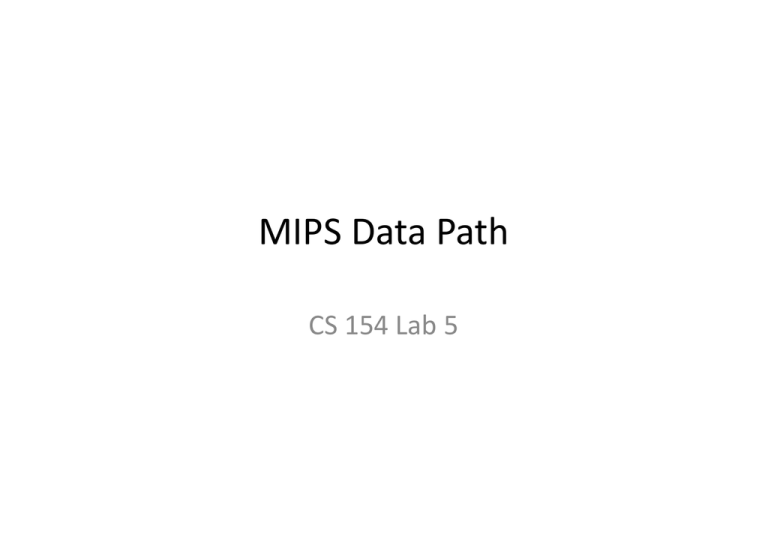MIPS Data Path
advertisement

MIPS Data Path
CS 154 Lab 5
What are the components?
• Sequential Circuit = Register Update Process +
Functional Unit (Combinational) • Registers: (Update process)
– Program Counter (PC)
– Instruction Register (IR)
– Register File Interface (RegA, RegB)
– ALU Interface (ALUout)
– Mem interface (Memory Data Register)
What are the components?
• Function Units (Combinational Component)
– Multiplexer (We will use a lot of MUX’es here)
– ALU
– Sign‐extension Unit (Immediate data)
– Shift (Branch and Jump address calculation)
– PC merger (PC calculation for Jump )
• Memory
How to design a data path?
• We must be able to execute instructions within the data path.
• Instruction type and format:
Type
‐31‐
format (bits)
R
opcode (6)
rs (5)
rt (5)
I
opcode (6)
rs (5)
rt (5)
J
opcode (6)
rd (5)
‐0‐
shamt (5)
funct (6)
immediate (16)
address (26)
• Visualize how data flow in the computer
How to design a data path?
• Common data path for all instructions:
– Instruction Fetch:
– Register Access:
– PC Update
– Memory Access:
IR <‐ Mem[PC];
RegA <‐ RF[rs];
RegB <‐ RF[rt];
RF[rd] <‐ ALUout;
PC <‐ PC + 4;
RF[rt] <‐ Mem[rs+Ext(Imm)];
Mem[AlUout] <‐ RF[rt];
Detailed Analysis of Instructions
• add, sub, and, or, sll, srl:
– R type, opcode = 0, Use function field for ALU
– Syntax: add rd, rs, rt
– Meaning: rd = rs + rt;
– RTL Description:
•
•
•
•
IR <‐ Mem[PC]; PC <‐ PC + 4;
RegA <‐ RF[rs]; RegB <‐ RF[rt];
ALUout <‐ RegA op RegB;
RF[rd] <‐ ALUout;
Detailed Analysis of Instructions
• addi, andi, ori
– I type, use opcode for ALU.
– Syntax: addi rt, rs, C
– Meaning: rt = rs + C (signed);
– RTL Description:
•
•
•
•
IR <‐ Mem[PC]; PC <‐ PC + 4;
RegA <‐ RF[rs]; Imm <‐ Ext(IR[15..0]);
ALUout <‐ RegA op Imm;
RF[rt] <‐ ALUout;
Detailed Analysis of Instructions
• LW, SW
– I type, access memory (load/store), relative address
– Syntax: lw rt, C(rs);
– Meaning: rt = Memory[rs + C];
– RTL Description:
•
•
•
•
•
IR <‐ Mem[PC]; PC <‐ PC + 4;
RegA <‐ RF[rs]; Imm <‐ Ext(IR[15..0]);
ALUout <‐ RegA + Imm;
MDR <‐ Mem[ALUout]; or Mem[ALUout] <‐ RF[rt];
RF[rt] <‐ MDR Detailed Analysis of Instructions
• BEQ, BNE
– I type, branch condition from ALU, relative address
– Syntax: beq rs, rt, C
– Meaning: if (rs == rt) go to PC+4+4*C
– RTL Description:
• IR <‐ Mem[PC]; PC <‐ PC + 4;
• RegA <‐ RF[rs]; RegB <‐ RF[rt]; ALUout <‐ PC + (Ext(IR[15..0]))<<2;
• if(RegA == RegB){PC <‐ ALUout;} Detailed Analysis of Instructions
• J
– J type, absolute address
– Syntax: j C
– Meaning: PC = (PC+4)[31:28] & C*4
– RTL Description:
• IR <‐ Mem[PC]; PC <‐ PC + 4;
• Nothing useful happens here…
• PC <‐ PC[31:28] & (IR[25:0] << 2);
Detailed Analysis of Instructions
• JAL
– J type, stores return address to r31.
– Syntax: j C
– Meaning: r31 = PC + 4; PC = (PC+4)[31:28] & C*4
– RTL Description:
• IR <‐ Mem[PC]; PC <‐ PC + 4;
• Nothing useful happens here
• RF[31] <‐ PC; PC <‐ PC[31:28] & (IR[25:0] << 2);
Summary of Data Path
• PC <‐ PC[31:28] & (IR[25:0] << 2); //jump PC <‐ ALUout;
//branch
PC <‐ PC + 4;
//other instructions
– We need a mux for new PC value (3 input)
• RF[rd]<‐ALUout
//R type
RF[rt] <‐ MDR //ld
– We need a mux for wr_addr;
– We also need a mux for d_in
(rd vs. rt vs. “31”)
(MEM vs. ALU)
Summary of Data Path
• ALUout <‐ RegA + RegB; //R type
ALUout <‐ RegA + Imm; //ld, sw
ALUout <‐ PC + (Ext(IR[15..0]))<<2 //beq, bne
PC <‐ PC + 4
//all instructions
– We need a mux for operand A in ALU (PC vs RegA)
– We need a mux for operand B in ALU (4 input)
• IR <‐ Mem[PC]; RF[rt] <‐ Mem[ALUout]; – We need a mux for memory address (PC vs ALU)



